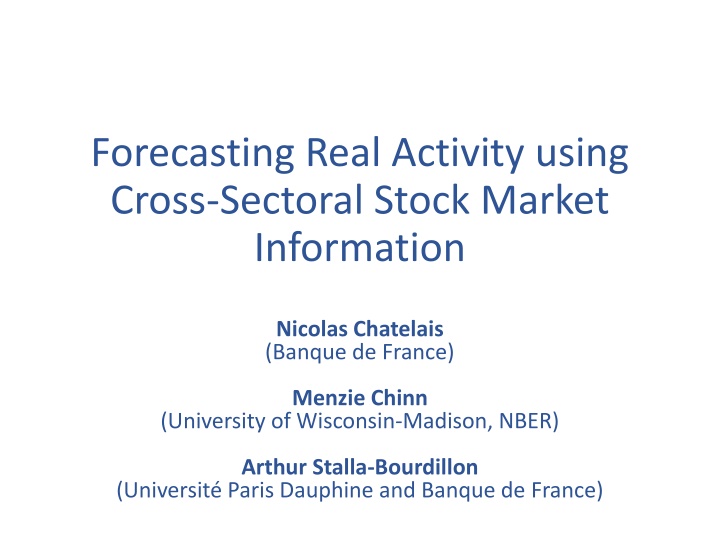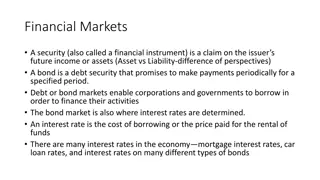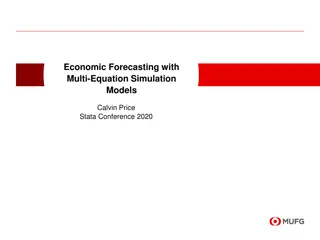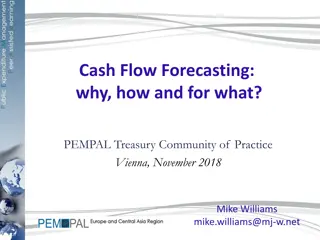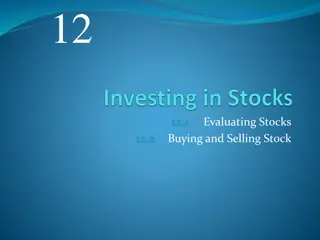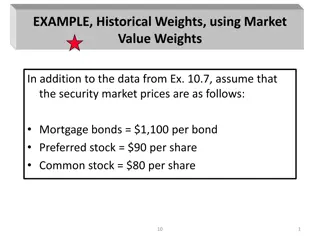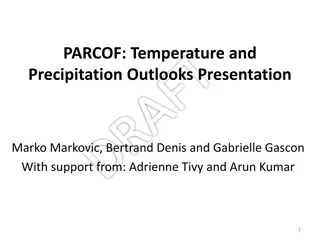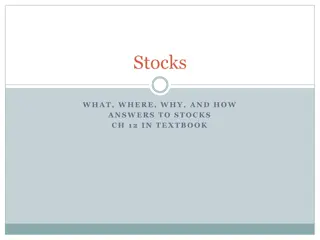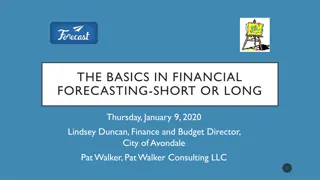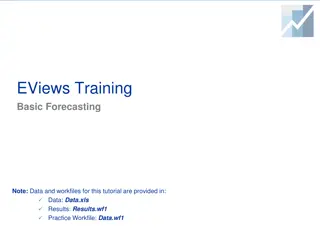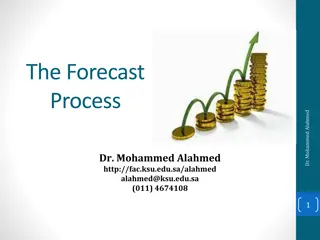Forecasting Real Activity Using Cross-Sectoral Stock Market Information
This study explores a novel approach to forecasting economic activity by utilizing sector-specific stock information, moving beyond traditional aggregate stock market analysis. By extracting predictive content from disaggregated sectoral stock prices, the research demonstrates improved accuracy in forecasting industrial production growth compared to conventional benchmarks. The methodology involves factor models to filter expected returns and cash flow components of sectoral equity variables, leading to insightful contributions and results.
Download Presentation

Please find below an Image/Link to download the presentation.
The content on the website is provided AS IS for your information and personal use only. It may not be sold, licensed, or shared on other websites without obtaining consent from the author.If you encounter any issues during the download, it is possible that the publisher has removed the file from their server.
You are allowed to download the files provided on this website for personal or commercial use, subject to the condition that they are used lawfully. All files are the property of their respective owners.
The content on the website is provided AS IS for your information and personal use only. It may not be sold, licensed, or shared on other websites without obtaining consent from the author.
E N D
Presentation Transcript
Forecasting Real Activity using Cross-Sectoral Stock Market Information Nicolas Chatelais (Banque de France) Menzie Chinn (University of Wisconsin-Madison, NBER) Arthur Stalla-Bourdillon (Universit Paris Dauphine and Banque de France)
MOTIVATION During the pandemic, aggregate stock prices didn t well predict economic activity. But stock price indices are driven up by other factors than future activity: The decline in interest rates. Changes in risk appetite The performance of IT-related sectors. Idea: Use sector-specific stock information to forecast economic activity. 2
SELECTIVE LITERATURE REVIEW Many papers rely on aggregate equity variables to predict economic activity: Fama (1990), Binswanger (2000), Liew and Vassalou (2003), Barhoumi, Darn and Ferrara (2009), McMillan (2019), Jardet and Meunier (2020) Very few papers rely on disaggregated stock predictors: Loungani et al. (1991), Liew and Vassalou (2000), Andersson and d'Agostino (2008), Huang, Jiang, Tu and Zhou (2014), Jagannathan and Marakani (2015), Lan (2020). Most of the time, previous studies rely on individual stock prices or on constrainedequity indicators (e.g. dispersion of micro-stock prices). 3
MAIN CONTRIBUTIONS AND RESULTS Contribution: To our knowledge: first paper to use factor models to extract the predictive content out of disaggregated sectoral stock prices. Results: Our factor better predicts IP growth compared to aggregate equity variables, and to conventional macro-benchmarks. Out of sample RMSFE from our factor model is about 60% that from lagged IP growth, and about 80% of term spread, at one year horizon Improved accuracy comes from the filtering of the expected return and the foreign cash flow componentsof sectoral equity variables. Our factor model overweights upstream sectors and value sectors (Zhang, 2005, Chue, 2018) 4
METHODOLOGY (I) Stock prices are noisy for macro-forecasting because they reflect: 1. Expected cash flows and expected returns/discount rates. 2. Domestic and foreign activity. With Campbell and Shiller (1988) formula for dividend yields (DYs): ?? ?? ? ?=1?? 1??[??+? ???,?+? ???,?+?] = ??= 1 ?+ How to disentangle these components? Kelly and Pruitt (KP, 2013) predict aggregate returns from sectoral equity ratios. Their factor is purged of the (noisy) cash flow-component. 5
METHODOLOGY (II) KP use a Partial Least Square (PLS) methodology: 1. ???= ??0+ ????+ + ???(time series) 2. ???= ??+ ?? ??+ ???(cross section) 3. ??+ = ?0+ ?1 ??+ ??+ (time series) Or, schematically: 1. ??= ?( 2. ??+ = ?0+ ?1 ?? ?)??? ??+ ??+ The more ???is correlated with ??+ the more it will affect ??through ( ?? ?). 6
METHODOLOGY (III) Model: Replicate KP, but to predict future economic activity and not future returns. Hopefully the factor will be correlated with future domestic cash flows, and not with the other components. Data: US postwar data, both macro and financial (monthly) variables: a. Macro: IP growth. b. Financial: aggregate DY, 44 GICS sectoral DYs, term spread Procedure: Comparing predictive accuracy of the factor model: a. To aggregate DY, to the lagged IP growth or to the term spread. b. Both in-sample and out-of-sample (rolling window). c. 12, 18 and 24 month-horizon. 7
RESULTS: COMPARISON - AGGREGATE VARIABLES (IN-SAMPLE) ??+ = ?0+ ?1 ??+ = ?0+ ?1 ??+ ??+ vs. ??+ = ?0+ ?1??+ ??+ ??+ ?2??+ ??+ : ?1significant (Newey-West) 8
RESULTS: COMPARISON - AGGREGATE VARIABLES (OUT-OF-SAMPLE) ??+ = ?0+ ?1 Most of the time significant results (Diebold and Mariano, 1995) ??+ ??+ vs. ??+ = ?0+ ?1??+ ??+ 9
RESULTS: COMPARISON PCA FACTORS (OUT-OF-SAMPLE) ??+ ?2??+ ??+ ??+ ?2??+ ?3??+ ??+ (Clark and West, 2007) Comparing: ??+ = ?0+ ?1 With: ??+ = ?0+ ?1 Table: Difference in RMSE (Factor model Corresponding PCA-factor benchmark) Model: Horizon 12 months 18 months 24 months 1 PCA-Factor -5.72* -13.31* -8.16* 1 PCA-Factor with lagged IP growth -3.43** -8.49 -7.79** 2 PCA-Factors -0.17** -0.16** -0.58* 2 PCA-Factors with lagged IP growth -0.85 -1.29 -7.54 3 PCA-Factors -0.18*** -0.36* -0.76* 3 PCA-Factors with lagged IP growth -5.62** -0.69 -6.55 10
RESULTS: COMPARISON - AGGREGATE VARIABLES (OUT-OF-SAMPLE, BY PERIOD) 11
RESULTS: FILTERING OF THE EXPECTED RETURN COMPONENT Sectoral DYs are all positively correlated with future returns. Factor weights are sometimes positive, sometimes negative. As a result, the factor is little correlated with future returns. 12
RESULTS: FILTERING OF THE FOREIGN CASH FLOW COMPONENT Our factor is little correlated with future returns. But also little correlated with the foreign component (future foreign IP growth). 13
CONCLUSION Overall: Factor model: outperforms aggregate equity variables and the term spread in-sample and out-of-sample. Adding the sectoral equity-factor to a classic PCA-predictive model significantly improves the forecasting accuracy. Factor model appears to filter out the expected returns and the future foreign cash flow components in sectoral equity variables. Factor model overweights upstream and value sectors. Policy perspective: additional indicator in the business cycle toolbox. 15
ANNEX III (IN-SAMPLE) ?? ? = ? + ?1???? ??+ ,??? + ?2????+ ?3???? ??,??? + ??+ ?? 18
ANNEX IV FACTOR TIME SERIES (IN-SAMPLE) Out-of-sample forecasts (12 month horizon): Term spread (July): +1.1% Factor model (June): -2.2% Market DY (June): +2.7% 19
